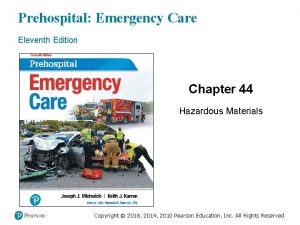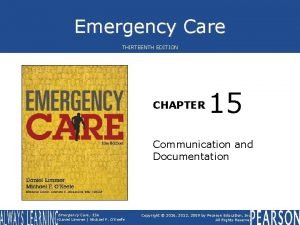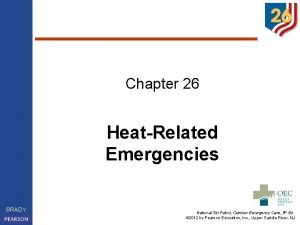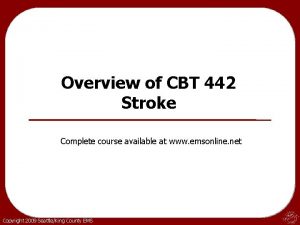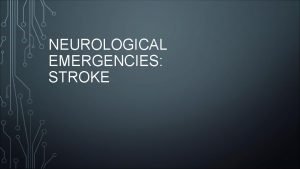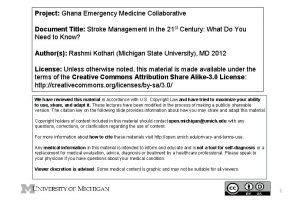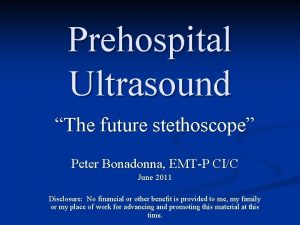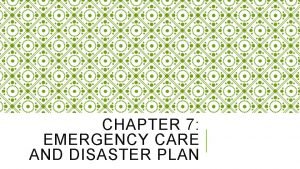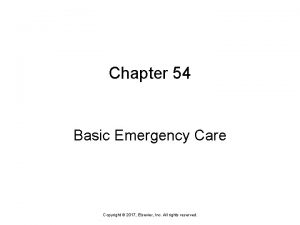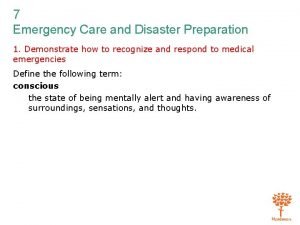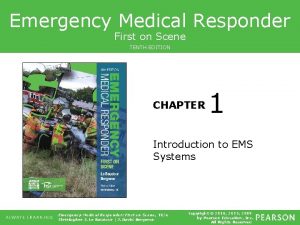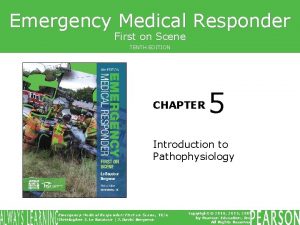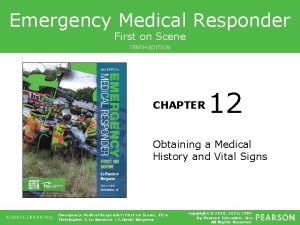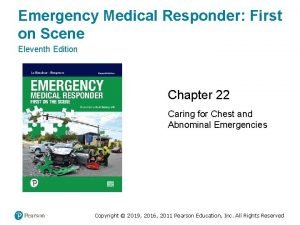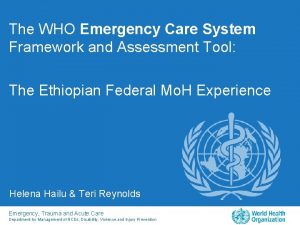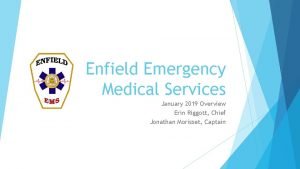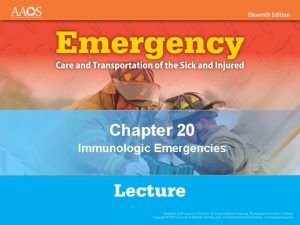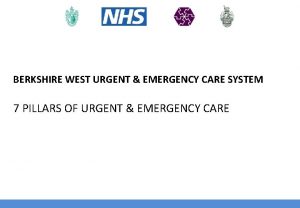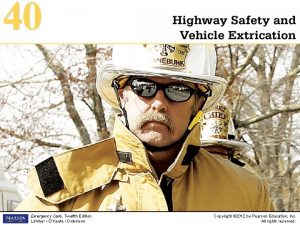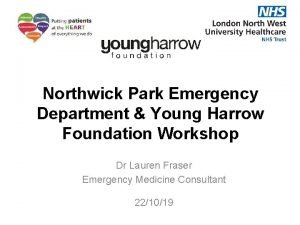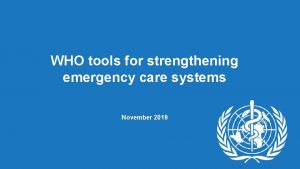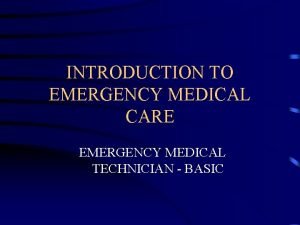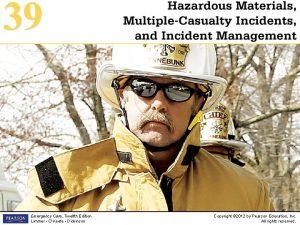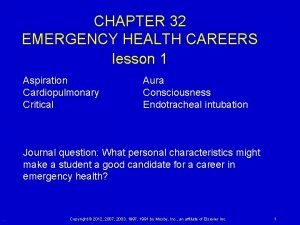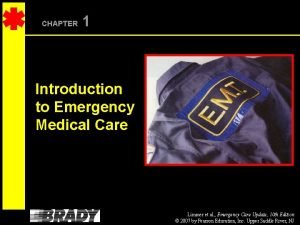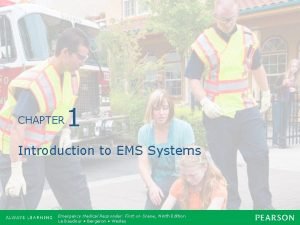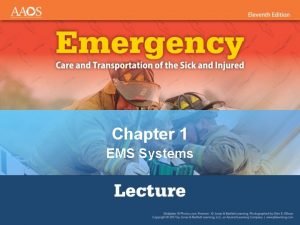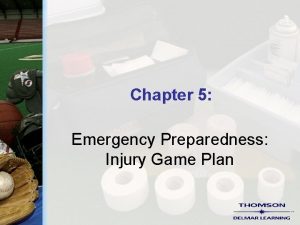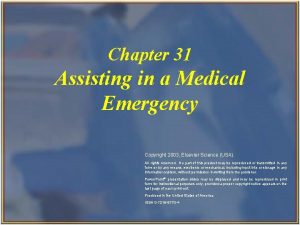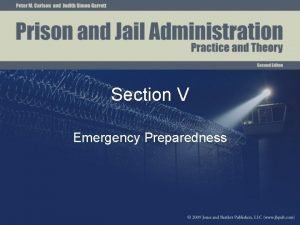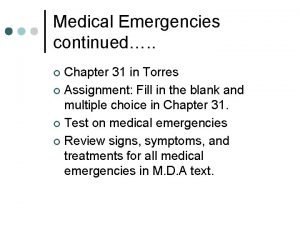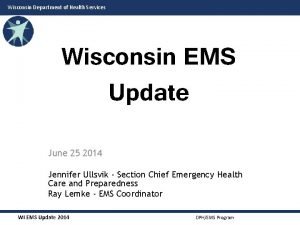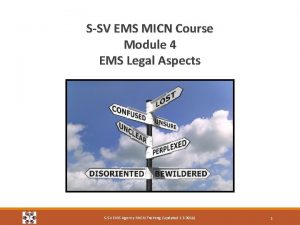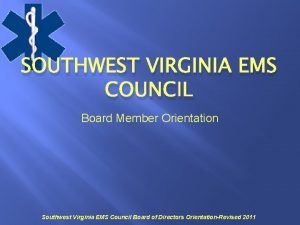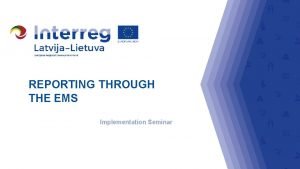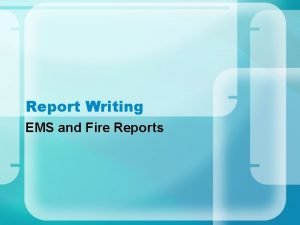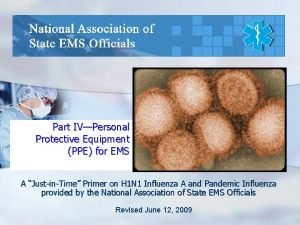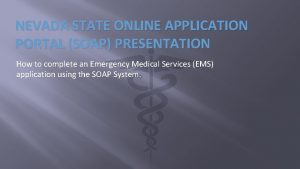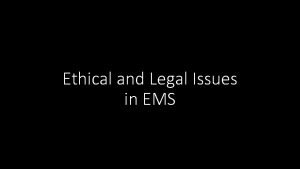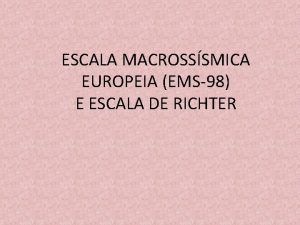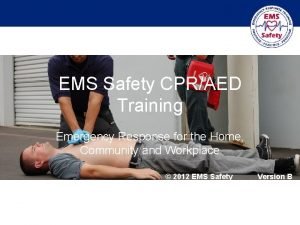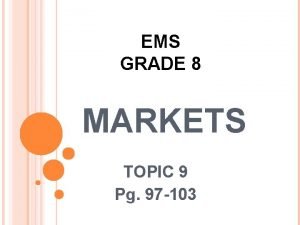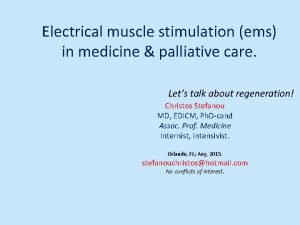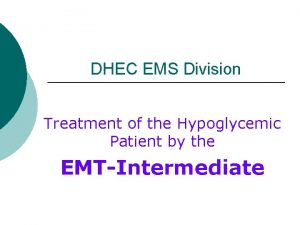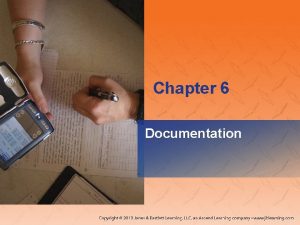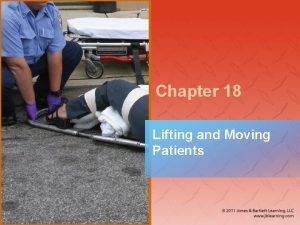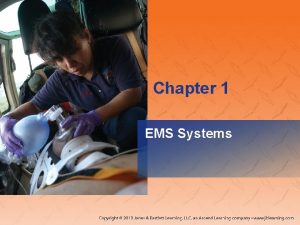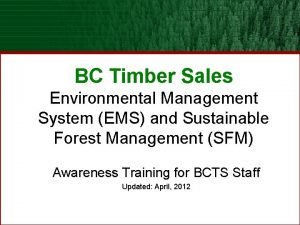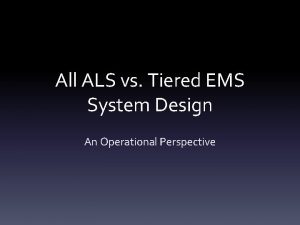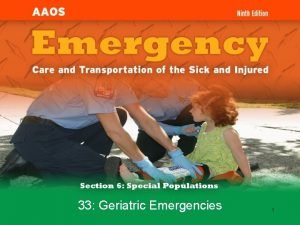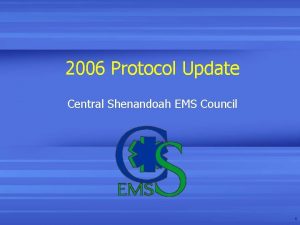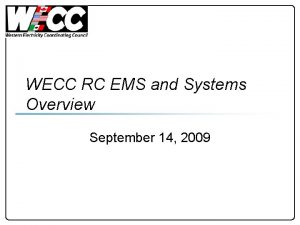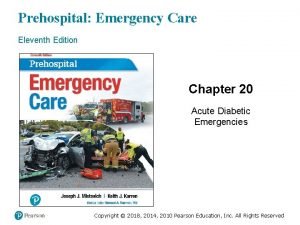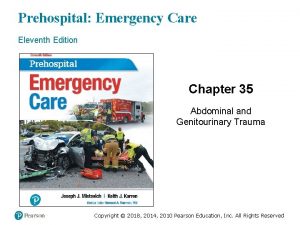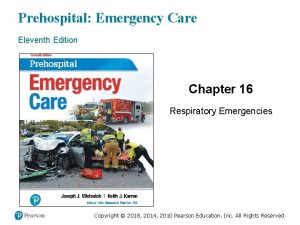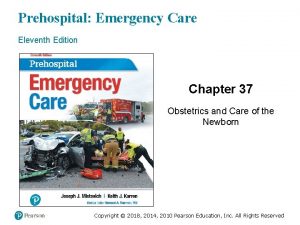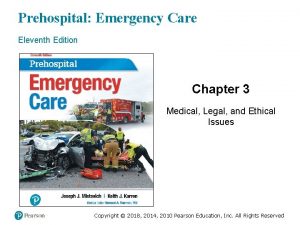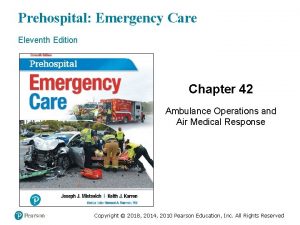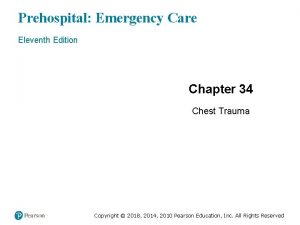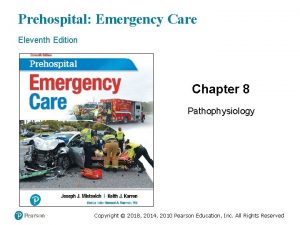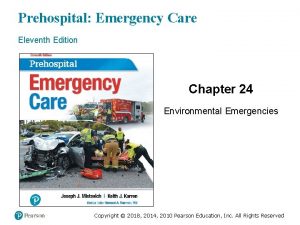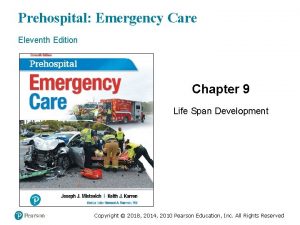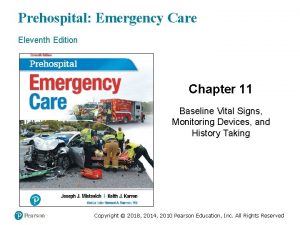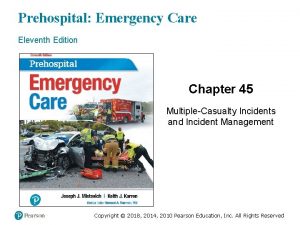Prehospital Emergency Care Eleventh Edition Chapter 46 EMS
























































































- Slides: 88

Prehospital: Emergency Care Eleventh Edition Chapter 46 EMS Response to Terrorism Involving Weapons of Mass Destruction Slides in this presentation contain hyperlinks. JAWS users should be able to get a list of links by using INSERT+F 7 Copyright © 2018, 2014, 2010 Pearson Education, Inc. All Rights Reserved

Learning Readiness • EMS Education Standards, text p. 1340. • Chapter Objectives, text p. 1340. • Key Terms, text p. 1340. • Purpose of lecture presentation versus textbook reading assignments. Copyright © 2018, 2014, 2010 Pearson Education, Inc. All Rights Reserved

Setting the Stage (1 of 2) • Overview of Lesson Topics – Weapons of Mass Destruction – Prehospital Response to Terrorism Involving WMD – Conventional Explosives and Incendiary Devices – Chemical Agents – Biological Agents – Nuclear Weapons and Radiation Copyright © 2018, 2014, 2010 Pearson Education, Inc. All Rights Reserved

Setting the Stage (2 of 2) • Overview of Lesson Topics – Personal Protection and Patient Decontamination – Active Shooter Incident – Cyberterrorism Copyright © 2018, 2014, 2010 Pearson Education, Inc. All Rights Reserved

Case Study Introduction EMTs Louis Fine and Alvin Hahn are called to a report of a sick person at a baseball stadium. Before they arrive, three more calls are reported to dispatch for additional sick people at the baseball stadium. Dispatch advises all responding units to use caution and to stage outside the stadium. An EMS supervisor is en route to establish incident command. Copyright © 2018, 2014, 2010 Pearson Education, Inc. All Rights Reserved

Case Study (1 of 3) • Why should arriving units use caution in this situation? • What could be responsible for several reports of sick people at an event? • What additional information is needed? Copyright © 2018, 2014, 2010 Pearson Education, Inc. All Rights Reserved

Introduction • Weapons of mass destruction (WMD) are a possibility EMTs must be prepared to respond too. Copyright © 2018, 2014, 2010 Pearson Education, Inc. All Rights Reserved

Weapons of Mass Destruction (1 of 4) • WMD are intended to cause widespread death and destruction. • The mnemonics CBRNE and B-NICE can be used to remember types of WMD. Copyright © 2018, 2014, 2010 Pearson Education, Inc. All Rights Reserved

Weapons of Mass Destruction (2 of 4) • CBRNE is commonly used to remember the types of WMDs. – Chemical – Biological – Radiological – Nuclear – Explosive Copyright © 2018, 2014, 2010 Pearson Education, Inc. All Rights Reserved

Weapons of Mass Destruction (3 of 4) • B-NICE is also commonly used to remember the types of WMDs. – Biological – Nuclear/radiological – Incendiary – Chemical – E - Explosive Copyright © 2018, 2014, 2010 Pearson Education, Inc. All Rights Reserved

Weapons of Mass Destruction (4 of 4) • Dissemination means bringing the WMD agent into contact with its intended target population. • The general approach to a WMD incident is the same as for other disasters with multiple casualties. Copyright © 2018, 2014, 2010 Pearson Education, Inc. All Rights Reserved

The World Trade Center Attack of September 11, 2001, Required a Massive Coordinated Effort for Rescue and Recovery Operations (© Suzanne Plunkett/AP Images) Copyright © 2018, 2014, 2010 Pearson Education, Inc. All Rights Reserved

Prehospital Response to Terrorism Involving WMD (1 of 8) • Supplies and Equipment – To ensure adequate equipment and response, there must be a community response to the disaster. – Each type of WMD requires different specialty equipment and supplies. – A plan must allow immediate deployment of individuals, equipment, and supplies. Copyright © 2018, 2014, 2010 Pearson Education, Inc. All Rights Reserved

Coordinated Community Medical Response to the World Trade Center Attack (© Louis Lanzano/AP Images) Copyright © 2018, 2014, 2010 Pearson Education, Inc. All Rights Reserved

Prehospital Response to Terrorism Involving WMD (2 of 8) • Medical Direction – There must be a plan to establish medical direction and verify credentials of responders from outside areas. – Communications may be unreliable, requiring reliance on standing orders. Copyright © 2018, 2014, 2010 Pearson Education, Inc. All Rights Reserved

Prehospital Response to Terrorism Involving WMD (3 of 8) • Provider Preparation – As always, EMS provider safety is the highest priority. – You must be aware of the indications of the weapons used and the potential for secondary effects of the attack or secondary attacks. Copyright © 2018, 2014, 2010 Pearson Education, Inc. All Rights Reserved

Prehospital Response to Terrorism Involving WMD (4 of 8) • Responding to the Scene – The earlier a WMD incident is recognized, the better. – The incident command system is used in WMD attacks. – Hazardous materials principles are used if the agent is a chemical. Copyright © 2018, 2014, 2010 Pearson Education, Inc. All Rights Reserved

Prehospital Response to Terrorism Involving WMD (5 of 8) • Issues of Scene Safety – Signs of a toxic and unsafe environment include: ▪ Respiratory distress. ▪ Dyspnea. ▪ Cough. ▪ Burning chest. ▪ Burning eyes. Copyright © 2018, 2014, 2010 Pearson Education, Inc. All Rights Reserved

Prehospital Response to Terrorism Involving WMD (6 of 8) • Issues of Scene Safety – Wear HEPA or N-95 masks, gloves, eye protection, and gowns for suspected communicable illnesses. – Approach from upwind. – Avoid confined spaces. – Entry must be made only by those with specialized training and protection. – Alert direction prior to transport. Copyright © 2018, 2014, 2010 Pearson Education, Inc. All Rights Reserved

Prehospital Response to Terrorism Involving WMD (7 of 8) • Role of the EMT at the Terrorist Incident Involving a WMD – Initial incident command scene size-up – Sector leader or officer, such as triage, treatment, or transportation – Providing care and transportation Copyright © 2018, 2014, 2010 Pearson Education, Inc. All Rights Reserved

Prehospital Response to Terrorism Involving WMD (8 of 8) • Role of the EMT at the Terrorist Incident Involving a WMD – Recognize locations or events that may be terrorist targets and use caution when responding to those locations. – The dead from terrorist incidents are now considered evidence. – Be aware that perpetrators may be among the injured. Copyright © 2018, 2014, 2010 Pearson Education, Inc. All Rights Reserved

Conventional Explosives and Incendiary Devices (1 of 8) • Conventional explosives and incendiary devices are the most widely used WMDs. • Explosives – Ignition of fuels that burn rapidly, causing hot gases to displace air, creating a shock wave – The blast moves out in all directions at supersonic speed causing blast injuries. Copyright © 2018, 2014, 2010 Pearson Education, Inc. All Rights Reserved

Conventional Explosives and Incendiary Devices (2 of 8) • Explosives – Improvised Explosive Devices ▪ Improvised from easily obtainable products ▪ Vehicle-Borne Improvised Explosive Device (VBIED) – Car or truck bomb. – Commonly use an explosive called ANFO (ammonium nitrate and fuel oil). Copyright © 2018, 2014, 2010 Pearson Education, Inc. All Rights Reserved

Conventional Explosives and Incendiary Devices (3 of 8) • Explosives – Common Explosive Compounds ▪ EGDN ▪ HMTD ▪ PETN ▪ RDX ▪ Semtex ▪ TATP Copyright © 2018, 2014, 2010 Pearson Education, Inc. All Rights Reserved

Conventional Explosives and Incendiary Devices (4 of 8) • Primary, Secondary, Tertiary, Quaternary, and Quinary Effects – The explosion blast is the primary effect. – The secondary effects result from flying debris or shrapnel. – Tertiary effects are injuries produced by the propulsion of the person’s body. – Quaternary effects include burn, crush, and inhalation injuries. Copyright © 2018, 2014, 2010 Pearson Education, Inc. All Rights Reserved

Conventional Explosives and Incendiary Devices (5 of 8) • Types of Injuries – Lungs ▪ Blast lung and pneumothorax may occur. ▪ Look for altered mental status, dyspnea, bloody sputum, chest pain, and stroke-like signs and symptoms. ▪ Use caution with positive pressure ventilation to avoid creating air emboli and tension pneumothorax. Copyright © 2018, 2014, 2010 Pearson Education, Inc. All Rights Reserved

Conventional Explosives and Incendiary Devices (6 of 8) • Types of Injuries – Abdomen ▪ Bowel may bleed or leak contents into the abdomen. ▪ Evisceration is possible. – Ears ▪ The eardrum may rupture and the inner ear bones may be disrupted. ▪ There may be hearing loss. Copyright © 2018, 2014, 2010 Pearson Education, Inc. All Rights Reserved

Conventional Explosives and Incendiary Devices (7 of 8) • Types of Injuries – Crush injuries ▪ They may occur from structural collapse and entrapment. ▪ Complications occur when the pressure on the crushed area is relieved. • Shrapnel injuries – Penetrating injuries can cause bleeding, hollow organ penetration, and fractures. Copyright © 2018, 2014, 2010 Pearson Education, Inc. All Rights Reserved

Conventional Explosives and Incendiary Devices (8 of 8) • Incendiary Devices – Be cautious of secondary and undetonated devices. – They primarily cause burns. – Assess burns according to the Rule of nine’s – Pay attention to airway and breathing. – Dress the burned areas. Copyright © 2018, 2014, 2010 Pearson Education, Inc. All Rights Reserved

Chemical Agents (1 of 16) • Properties of Chemical Weapons – Can be dispersed using munitions or aerosol devices – The tendency of an agent to evaporate and create vapors is its volatility. – Agents that do not evaporate are characterized as persistent. – Evaporation is affected by temperature. Copyright © 2018, 2014, 2010 Pearson Education, Inc. All Rights Reserved

Chemical Agents (2 of 16) • Types of Chemical Agents – Nerve agents – Vesicants – Cyanide – Pulmonary agents – Riot-control agents – Toxic industrial chemicals Copyright © 2018, 2014, 2010 Pearson Education, Inc. All Rights Reserved

Chemical Agents (3 of 16) • Types of Chemical Agents – Nerve Agents ▪ Potent and easily made ▪ Block the enzyme that breaks down the neurotransmitter acetylcholine (ACh), allowing accumulation of ACh ▪ overstimulation of the muscles, smooth muscles, glands, and nerves as result. Copyright © 2018, 2014, 2010 Pearson Education, Inc. All Rights Reserved

Table 46 -1 Nerve Agents • Tabun (GA) • Sarin (GB) • Soman (GD) • GF • Methylphosphonothioic acid (VX) • Novichok Agents (Russian nerve agents) Copyright © 2018, 2014, 2010 Pearson Education, Inc. All Rights Reserved

Table 46 -2 Signs and Symptoms of Nerve Agent Exposure Vapor Small Exposure Large Exposure Blank Runny nose, mild dyspnea, pupillary constriction Sudden onset of unresponsiveness, seizures, apnea, copious secretions, pupillary constriction Liquid Small Exposure Large Exposure Blank Localized sweating, nausea, vomiting, fatigue Sudden onset of unresponsiveness, seizures, apnea, paralysis, copious secretions Copyright © 2018, 2014, 2010 Pearson Education, Inc. All Rights Reserved

Chemical Agents (4 of 16) • Types of Chemical Agents – Nerve Agents ▪ Signs and symptoms: – Respiratory failure from paralysis of respiratory muscles. – Copious airway secretions and bronchoconstriction. – SLUDGE—salivation, lacrimation, urination, defecation, gastric distress, and emesis. Copyright © 2018, 2014, 2010 Pearson Education, Inc. All Rights Reserved

Chemical Agents (5 of 16) • Types of Chemical Agents – Nerve Agents ▪ Emergency Medical Care – Ensure an adequate airway and ventilation; be prepared to suction. – The medications atropine and pralidoxime are antidotes. – To combat seizures, benzodiazepine (diazepam, lorazepam, or midazolam) should be used. Copyright © 2018, 2014, 2010 Pearson Education, Inc. All Rights Reserved

Chemical Agents (6 of 16) • Types of Chemical Agents – Vesicants ▪ Cause blistering, burning, and tissue damage ▪ Agents include sulfur and nitrogen mustards, lewisite, and phosgene oxime. Copyright © 2018, 2014, 2010 Pearson Education, Inc. All Rights Reserved

Chemical Agents (7 of 16) • Types of Chemical Agents – Vesicants ▪ Signs and symptoms: – Burning, redness, blistering, and necrosis. – Stinging, tearing, and development of ulcers in the eyes. – Shortness of breath, coughing, wheezing, and pulmonary edema. – Nausea and vomiting. – Fatigue. Copyright © 2018, 2014, 2010 Pearson Education, Inc. All Rights Reserved

Chemical Agents (8 of 16) • Types of Chemical Agents – Vesicant ▪ Emergency medical care – Irrigation – Manage chemical burns – Apply a dry, sterile dressing – Lewisite, an arsenic-based agent, has an antidote called dimercaprol Copyright © 2018, 2014, 2010 Pearson Education, Inc. All Rights Reserved

Chemical Agents (9 of 16) • Types of Chemical Agents – Cyanide ▪ Rapidly disrupts the ability of the cells to use oxygen ▪ May be inhaled and ingested ▪ Death may occur in 6 to 8 minutes with high doses. Copyright © 2018, 2014, 2010 Pearson Education, Inc. All Rights Reserved

Chemical Agents (10 of 16) • Types of Chemical Agents – Cyanide ▪ Signs and symptoms: – Anxiety. – Weakness and dizziness. – Nausea. – Muscular trembling. – Tachycardia and tachypnea or apnea. – Seizures and unresponsiveness. – Pale, cyanotic, or normal color skin. Copyright © 2018, 2014, 2010 Pearson Education, Inc. All Rights Reserved

Chemical Agents (11 of 16) • Types of Chemical Agents – Cyanide Exposure ▪ Emergency treatment: – Manage the airway, breathing, and oxygenation. – There antidotes available. • Nitrites and sodium thiosulfate • Hydroxocobalamin Copyright © 2018, 2014, 2010 Pearson Education, Inc. All Rights Reserved

Chemical Agents (12 of 16) • Types of Chemical Agents – Pulmonary Agents ▪ Include phosgene, other halogen compounds, and nitrogen-oxygen compounds ▪ Act primarily to cause lung injury Copyright © 2018, 2014, 2010 Pearson Education, Inc. All Rights Reserved

Chemical Agents (13 of 16) • Types of Chemical Agents – Pulmonary Agent Exposure ▪ Signs and symptoms: – Tearing and runny nose. – Throat irritation. – Dyspnea and wheezing. – Cough. – Crackles and stridor. – Secretions. Copyright © 2018, 2014, 2010 Pearson Education, Inc. All Rights Reserved

Chemical Agents (14 of 16) • Types of Chemical Agents – Pulmonary agent exposure ▪ Emergency medical treatment: – Manage the airway and breathing; be prepared to suction and administer oxygen. Copyright © 2018, 2014, 2010 Pearson Education, Inc. All Rights Reserved

Chemical Agents (15 of 16) • Types of Chemical Agents – Riot Control Agents ▪ Tear gas and pepper spray ▪ cause extreme irritation of the eyes, nose, mouth, skin, and respiratory tract. ▪ Emergency medical care is supportive and may include irrigation of the eyes. Copyright © 2018, 2014, 2010 Pearson Education, Inc. All Rights Reserved

Chemical Agents (16 of 16) • Types of Chemical Agents – Toxic Industrial Chemicals ▪ They may be obtained from hijacking rail or truck transportation of chemicals or sabotage of chemical plants. ▪ The approach and treatment depends on the agent involved. Copyright © 2018, 2014, 2010 Pearson Education, Inc. All Rights Reserved

Case Study (2 of 3) The incident commander communicates with security officers inside the stadium and learns that now there about two dozen individuals complaining of coughing, gagging, and irritation of the eyes, nose, and mouth. As they are communicating, there additional reports of affected patients from other areas of the stadium. Copyright © 2018, 2014, 2010 Pearson Education, Inc. All Rights Reserved

Case Study (3 of 3) • What should be the approach to this situation? • Where should EMS units be located? • What special resources are needed? Copyright © 2018, 2014, 2010 Pearson Education, Inc. All Rights Reserved

Biological Agents (1 of 13) • They consist of living organisms or their toxins. • Small amounts can cause widespread illness and may take days to detect. • Dispersal methods vary. • The respiratory tract is the most common portal of entry. Copyright © 2018, 2014, 2010 Pearson Education, Inc. All Rights Reserved

Biological Agents (2 of 13) • Specific Biological Agents – Groups of biological agents include: ▪ Pneumonia-like agents. ▪ Encephalitis-like agents. ▪ Biological toxins. ▪ Other agents. Copyright © 2018, 2014, 2010 Pearson Education, Inc. All Rights Reserved

Biological Agents (3 of 13) • Specific Biological Agents – Pneumonia-Like Agents ▪ Present with fever and difficulty breathing, and include: – Anthrax. – Plague. – Tularemia. ▪ Encephalitis-Like Agents include: – Smallpox. – Venezuelan equine encephalitis. Copyright © 2018, 2014, 2010 Pearson Education, Inc. All Rights Reserved

Biological Agents (4 of 13) • Specific Biological Agents – Biological Toxins ▪ Botulinum – Descending paralysis – Double vision – Blurred vision – Dry mouth and throat – Difficulty speaking and swallowing – Dyspnea and respiratory failure Copyright © 2018, 2014, 2010 Pearson Education, Inc. All Rights Reserved

Biological Agents (5 of 13) • Specific Biological Agents – Biological Toxins ▪ Ricin – Weakness – Fever – Cough – Hypothermia – Death Copyright © 2018, 2014, 2010 Pearson Education, Inc. All Rights Reserved

Biological Agents (6 of 13) • Specific Biological Agents – Biological Toxins ▪ Staphylococcus enterotoxin 13 – Fever – Chills – Headache – Body aches – Nonproductive cough Copyright © 2018, 2014, 2010 Pearson Education, Inc. All Rights Reserved

Biological Agents (7 of 13) • Specific Biological Agents – Biological Toxins ▪ Epsilon toxin – Cough, wheezing, and shortness of breath – Respiratory failure – Death Copyright © 2018, 2014, 2010 Pearson Education, Inc. All Rights Reserved

Biological Agents (8 of 13) • Specific Biological Agents – Biological Toxins ▪ Trichothecene myotoxins – Pain – Itching and lesions – Runny nose, and sneezing – Sloughing skin – Dyspnea and wheezing – Chest pain – Hemoptysis Copyright © 2018, 2014, 2010 Pearson Education, Inc. All Rights Reserved

Biological Agents (9 of 13) • Specific Biological Agents – Other Biological Agents ▪ Cholera – Vomiting, abdominal distention, and profuse diarrhea – Severe dehydration – Little or no fever Copyright © 2018, 2014, 2010 Pearson Education, Inc. All Rights Reserved

Biological Agents (10 of 13) • Specific Biological Agents – Other Biological Agents ▪ Viral hemorrhagic fevers – Malaise – Body aches – Headache – Vomiting – Flushing and petechiae – Easy bleeding, hypotension, and shock Copyright © 2018, 2014, 2010 Pearson Education, Inc. All Rights Reserved

Biological Agents (11 of 13) • Specific Biological Agents – Other Biological Agents ▪ Brucellosis – Fever – Malaise – Body aches – Joint pain – Headache – Cough Copyright © 2018, 2014, 2010 Pearson Education, Inc. All Rights Reserved

Biological Agents (12 of 13) • Specific Biological Agents – Emergency medical care for biological agent ▪ Prehospital care is supportive. ▪ Recognition and contacting public health officials is crucial. ▪ Smallpox, plague, and Ebola are highly contagious; use appropriate personal protective equipment. Copyright © 2018, 2014, 2010 Pearson Education, Inc. All Rights Reserved

Biological Agents (13 of 13) • Specific Biological Agents – Emergency medical care for biological agent ▪ Hospital care includes antibiotics and antitoxin. ▪ Immunizations and prophylactic treatment are used in some cases. Copyright © 2018, 2014, 2010 Pearson Education, Inc. All Rights Reserved

Click on the WMD Agent Below That is a Biological Agent A. Phosgene B. Nerve agents C. Ricin D. Hydroxocobalamin Copyright © 2018, 2014, 2010 Pearson Education, Inc. All Rights Reserved

Nuclear Weapons and Radiation (1 of 11) • Three primary mechanisms of death – Radiation – Blast – Thermal burns • Radiation – Energy released from radioactive atoms passes through and changes the structure of molecules in cells of the human body. Copyright © 2018, 2014, 2010 Pearson Education, Inc. All Rights Reserved

Nuclear Weapons and Radiation (2 of 11) • Radiation – The cells may die, repair, or produce mutated cells. – X-ray/gamma radiation is the most penetrating type and can travel long distances. – Neutron radiation is a powerful, damaging particle associated with nuclear reactors and nuclear bombs. Copyright © 2018, 2014, 2010 Pearson Education, Inc. All Rights Reserved

Nuclear Weapons and Radiation (3 of 11) • Radiation – Beta radiation is a low-speed, low-energy particle that is easily stopped by 6 to 10 feet of air, clothing, or the first few millimeters of skin, but poses a serious hazard if ingested. – Alpha radiation is heavy, slow-moving, and easily stopped, but poses a serious threat if inhaled or ingested. Copyright © 2018, 2014, 2010 Pearson Education, Inc. All Rights Reserved

Nuclear Weapons and Radiation (4 of 11) • Radiation – Exposure associated with a nuclear explosion ▪ Primary exposure – Radiation injury that occurs during or shortly after the detonation ▪ Fallout – Radioactive dust and particles that can be life threatening to people far from the epicenter of the detonation. Copyright © 2018, 2014, 2010 Pearson Education, Inc. All Rights Reserved

Nuclear Weapons and Radiation (5 of 11) • Blast Injuries – Nuclear detonation causes a rapid heating of air and an explosively expanding gas cloud. – Injuries are the same as those from conventional explosives. – The windblast can reach 160 miles per hour. Copyright © 2018, 2014, 2010 Pearson Education, Inc. All Rights Reserved

Nuclear Weapons and Radiation (6 of 11) • Thermal burns – Cause most deaths and injuries from nuclear explosion – Heating is a short duration, but very intense. – The eyes can be damaged from the intense light. Copyright © 2018, 2014, 2010 Pearson Education, Inc. All Rights Reserved

Nuclear Weapons and Radiation (7 of 11) • Radiological Dispersal Devices/Radiological Exposure Devices – “Dirty Bomb” ▪ A conventional explosive attached to radioactive materials ▪ Risk of widespread radiation illness and contamination of the environment – A Radiological Exposure Device ▪ Does not use an explosive Copyright © 2018, 2014, 2010 Pearson Education, Inc. All Rights Reserved

Nuclear Weapons and Radiation (8 of 11) • Improvised Nuclear Device – Assembled and built specifically for a terrorist incident. – Low-quality materials – May not detonate properly Copyright © 2018, 2014, 2010 Pearson Education, Inc. All Rights Reserved

Nuclear Weapons and Radiation (9 of 11) • Assessment and Care for Nuclear Detonation and Radiation Injuries – Assessment ▪ Most destruction and death is nearest the center of the blast. ▪ There is less death and injury further from the blast. ▪ Identify the time after exposure that the patient complains of any radiation related signs and symptoms. Copyright © 2018, 2014, 2010 Pearson Education, Inc. All Rights Reserved

Nuclear Weapons and Radiation (10 of 11) • Assessment and Care for Nuclear Detonation and Radiation Injuries – Signs and symptoms: ▪ Nausea, fatigue, malaise, and clotting disorders. ▪ Vomiting, no appetite, diarrhea, and fluid loss. ▪ Reddening of the skin. ▪ Rapid onset of incapacitation, cardiovascular collapse, confusion, and burning sensation. Copyright © 2018, 2014, 2010 Pearson Education, Inc. All Rights Reserved

Nuclear Weapons and Radiation (11 of 11) • Assessment and Care for Nuclear Detonation and Radiation Injuries – Emergency Medical Care ▪ Protect yourself and patients from further radioactive exposure. ▪ Treat thermal and blast injuries. ▪ Manage airway, breathing, and oxygenation. ▪ Iodine tablets can help protect against long-term effects of radiation. Copyright © 2018, 2014, 2010 Pearson Education, Inc. All Rights Reserved

Personal Protection and Patient Decontamination • Personal protective equipment is required for chemical, biological, and radiological/nuclear exposure. • Apply the principles of hazardous material response. • Apply the principles of time, distance, and shielding for radiation exposure. • Apply the principles of decontamination as for hazardous materials exposure. Copyright © 2018, 2014, 2010 Pearson Education, Inc. All Rights Reserved

Active Shooter Incident • Tactical EMS – Tactical emergency medicine(TEM) is not normally taught as part of most EMT or paramedic curriculums. – No one specific operational setup for a TEM exists. Copyright © 2018, 2014, 2010 Pearson Education, Inc. All Rights Reserved

Cyberterrorism • The use of computer network tools to shut down critical national infrastructure. • Medical devices and technology rely on networked computer systems. • Protected health information (PHI) can be illegally accessed. Copyright © 2018, 2014, 2010 Pearson Education, Inc. All Rights Reserved

Case Study Conclusion (1 of 4) Louis and Allan, along with other responding units, are relocated to a position upwind from the stadium. Meanwhile, security reports that several of the affected patients reported seeing canisters that they thought might be tear gas or pepper spray. Copyright © 2018, 2014, 2010 Pearson Education, Inc. All Rights Reserved

Case Study Conclusion (2 of 4) Incident command works with security to stage an orderly evacuation of the stadium, and orders a decontamination area to be set up at the stadium exit. Triage, treatment, and transport sectors are established. Copyright © 2018, 2014, 2010 Pearson Education, Inc. All Rights Reserved

Case Study Conclusion (3 of 4) In all, nearly 100 people are decontaminated by hazardous materials personnel at the scene. Hazardous materials crews confirm that the substance involved was a riot control agent. Ultimately 36 of the patients are transported for further treatment at area hospitals. Copyright © 2018, 2014, 2010 Pearson Education, Inc. All Rights Reserved

Case Study Conclusion (4 of 4) The attack is later determined to be the work of a small domestic group staging a protest. Copyright © 2018, 2014, 2010 Pearson Education, Inc. All Rights Reserved

Lesson Summary (1 of 2) • WMD are intended to produce widespread death and destruction. • WMD may be chemical, biological, radiological, nuclear, or explosive agents. • Conventional explosive agents have the greatest likelihood of being used in an attack. Copyright © 2018, 2014, 2010 Pearson Education, Inc. All Rights Reserved

Lesson Summary (2 of 2) • Preplanning is crucial to management of the incident and the patients. • Preplanning must consider supplies and equipment, medical direction, provider education and preparation, response to the scene, and scene safety issues. Copyright © 2018, 2014, 2010 Pearson Education, Inc. All Rights Reserved

Correct! Ricin is a biological toxin. Click here to return to the program. Copyright © 2018, 2014, 2010 Pearson Education, Inc. All Rights Reserved

Incorrect (1 of 3) Phosgene is a chemical agent. Click here to return to the quiz. Copyright © 2018, 2014, 2010 Pearson Education, Inc. All Rights Reserved

Incorrect (2 of 3) Nerve agents are chemical agents. Click here to return to the quiz. Copyright © 2018, 2014, 2010 Pearson Education, Inc. All Rights Reserved

Incorrect (3 of 3) Hydroxocobalamin is an antidote to cyanide, a chemical agent. Click here to return to the quiz. Copyright © 2018, 2014, 2010 Pearson Education, Inc. All Rights Reserved

Copyright © 2018, 2014, 2010 Pearson Education, Inc. All Rights Reserved
 Prehospital emergency care 11th edition chapter 1
Prehospital emergency care 11th edition chapter 1 Prehospital emergency care 10th edition
Prehospital emergency care 10th edition Pre-hospital communication
Pre-hospital communication Prehospital emergency care 11th edition
Prehospital emergency care 11th edition Prehospital emergency care 11th edition
Prehospital emergency care 11th edition Prehospital emergency care 11th edition
Prehospital emergency care 11th edition Management eleventh edition stephen p robbins
Management eleventh edition stephen p robbins Management eleventh edition
Management eleventh edition Management eleventh edition
Management eleventh edition Management eleventh edition stephen p robbins
Management eleventh edition stephen p robbins Emergency care 13th edition
Emergency care 13th edition Outdoor emergency care 6th edition
Outdoor emergency care 6th edition Chadha committee
Chadha committee Eleventh 5 year plan
Eleventh 5 year plan Eleventh plan
Eleventh plan For his eleventh birthday elvis presley
For his eleventh birthday elvis presley Cincinatti stroke scale
Cincinatti stroke scale Lams stroke scale
Lams stroke scale Cincinnati prehospital stroke scale
Cincinnati prehospital stroke scale Peter bonadonna
Peter bonadonna Emergency care and disaster preparation chapter 7
Emergency care and disaster preparation chapter 7 Chapter 54 basic emergency care
Chapter 54 basic emergency care Chapter 8 emergency care first aid and disasters
Chapter 8 emergency care first aid and disasters Emergency care and disaster preparation
Emergency care and disaster preparation Health care levels primary secondary tertiary
Health care levels primary secondary tertiary Emergency medical responder first on scene 10th edition
Emergency medical responder first on scene 10th edition Cardiopulmonary
Cardiopulmonary Brachial pulse location
Brachial pulse location Emergency medical responder first on scene 11th edition
Emergency medical responder first on scene 11th edition Using mis (10th edition) 10th edition
Using mis (10th edition) 10th edition Report
Report Emergency care system framework
Emergency care system framework Emergency care and first aid ppt
Emergency care and first aid ppt Emergency care enfield
Emergency care enfield Care for a victim of an immunologic emergency
Care for a victim of an immunologic emergency 7 pillars of urgent and emergency care
7 pillars of urgent and emergency care Golden rules of emergency care
Golden rules of emergency care Introduction to emergency medical care
Introduction to emergency medical care Northwick park emergency department
Northwick park emergency department Interagency integrated triage tool
Interagency integrated triage tool Tdh ems
Tdh ems Introduction to emergency medical care
Introduction to emergency medical care The goal of modern emergency care includes
The goal of modern emergency care includes Emergency care limmer
Emergency care limmer Introduction to emergency medical care
Introduction to emergency medical care Ems systems chapter 1
Ems systems chapter 1 Ems systems chapter 1
Ems systems chapter 1 Chapter 5 emergency preparedness injury game plan
Chapter 5 emergency preparedness injury game plan Chapter 36 emergency preparedness and protective practices
Chapter 36 emergency preparedness and protective practices Chapter 31 assisting in a medical emergency
Chapter 31 assisting in a medical emergency Chapter 36 emergency preparedness and protective practices
Chapter 36 emergency preparedness and protective practices Define medical emergency chapter 31
Define medical emergency chapter 31 Standard 3 care certificate
Standard 3 care certificate Polii magnetului
Polii magnetului Palliative care vs hospice care
Palliative care vs hospice care Animalele se inmultesc prin
Animalele se inmultesc prin Care sunt simturile prin care sunt evocate
Care sunt simturile prin care sunt evocate Puwer
Puwer Hip fracture clinical care standard
Hip fracture clinical care standard Unit 2 equality diversity and rights
Unit 2 equality diversity and rights Wi ems wards
Wi ems wards Mercedwe
Mercedwe Ems felvételre kijelölt posták
Ems felvételre kijelölt posták Verdant thermostat occupancy sensor
Verdant thermostat occupancy sensor Ssv ems
Ssv ems Ems equipment repair
Ems equipment repair Southwest va ems council
Southwest va ems council Ems latlit
Ems latlit Ems report writing
Ems report writing Ems meaning
Ems meaning Nevada ems soap
Nevada ems soap Ems iso 9001
Ems iso 9001 Eduphoria emsisd
Eduphoria emsisd Ethical issues in ems
Ethical issues in ems Escala macrossismica europeia
Escala macrossismica europeia Ems safety cpr
Ems safety cpr Factors of production ems grade 8
Factors of production ems grade 8 Chart method ems
Chart method ems Dhec ems
Dhec ems Ems soap narrative examples
Ems soap narrative examples Ems lifting and moving patients
Ems lifting and moving patients National ems standards
National ems standards Bcts ems
Bcts ems Ems system design
Ems system design Gems assessment
Gems assessment General ledger grade 9
General ledger grade 9 Central shenandoah ems
Central shenandoah ems Ems cortal
Ems cortal Wrf ems
Wrf ems





